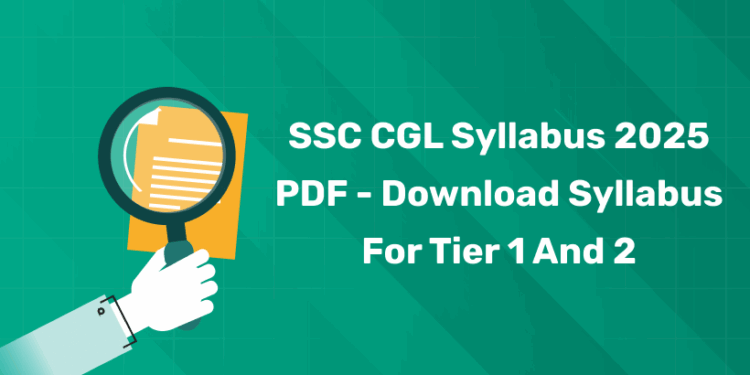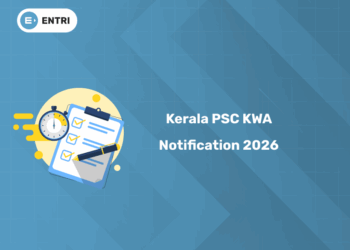Table of Contents
The Staff Selection Committee (SSC) will be released the syllabus along with the official notification. According to the current pattern, there will only be two tiers (Tier I and Tier II) instead of the usual four. Tier I will be qualifying in nature and will be compulsory for all while Tier II will be merit based and also based on the post one has applied for. All sections of Paper I must be qualified separately.
Attempt Free Mock Tests for SSC CGL! Get Free Trial Here!
SSC CGL Exam Pattern 2025
SSC CGL has 2 phases: Tier- 1, and Tier- 2 according to the new exam pattern.
SSC CGL Tier 1 Exam Pattern
| Subject | Questions | Maximum Marks |
| General Intelligence & Reasoning | 25 | 50 |
| Quantitative Aptitude | 25 | 50 |
| General English | 25 | 50 |
| General Awareness | 25 | 50 |
Note: Total Duration of Tier 1 Exam is 60 minutes
SSC CGL Tier 2 Exam Pattern
In this phase, two exams are conducted on the same day, the details of the Tier-II exams are listed below. Merit list will be prepared based on the overall performance of candidates in Tier-II Examination only. Total time duration is 2 hours 15 minutes for Paper – 1 and 2 hours for Paper – 2 and 3 each.
| Paper | Session | Section | Subject | Questions | Marks |
| I | I (2 hours and 15 minutes) | I (1 hour ) | Module I – Mathematical abilities Module II – Reasoning and General Intelligence | 3030Total – 60 | 60 x 3= 180 |
| II (1 hour ) | Module I – English Language Comprehension Module II – General Awareness | 4525 Total = 70 |
70 x 3 =210 | ||
| III (15 minutes) | Module – I – Computer Knowledge module | 20 | 20 x 3 = 60 | ||
| II (15 minutes) | III | Module – II : Data Entry Speed Test | One data entry task | ||
| II | 2 hours | Statistics (Paper I & II as above) | 100 | 100 x 2= 200 | |
| III | 2 hours | General Studies (Paper I & II as above) (Finance & Economics) | 100 | 100 x 2= 200 | |
| Total | 500 | 850 |
Exam pattern details – Total time
- Candidates will be given 2 Hours or 120 Minutes to complete each paper.
- The questions in the SSC CGL Tier-II will be of objective type in which candidates will have to choose one correct answer from the given four options.
- 0.25 mark will be deducted on each wrong answer in the English Language and Comprehension (Paper-II) of the SSC CGL Tier-II exam and 0.50 mark in Paper I, Paper III, and Paper IV.
- Paper I and Paper II in Tier-II are compulsory for all Group B and C posts.
- Paper III is compulsory for candidates who have applied for a Junior Statistical Officer (JSO) post in the Ministry of Statistics and Programme Implementation.
- Paper IV is compulsory for those candidates who are selected after taking the Tier I exam and registered for the posts of Assistant Audit Officer/ Assistant Accounts Officer.
CGL Previous Year CUTOFF SCORES
SSC CGL Exam Syllabus 2025 PDF
1: In a certain code language, ‘ROK’ is written as ‘44’ and ‘MIG’ is written as ‘29’. What will be the code for ‘TAL’ in that code language?
SSC CGL Exam Syllabus 2025
Tier-01 Preliminary Exam
General Intelligence and Reasoning
- Analogies, similarities, and differences,
- Space visualization, spatial orientation,
- Problem-solving, analysis, judgment, decision making,
- Visual memory, discrimination, observation, relationship concepts,
- Arithmetical reasoning and figural classification,
- Arithmetic number series, non-verbal series,
- Coding and decoding,
- Statement conclusion, syllogistic reasoning-Semantic Analogy, Symbolic/ Number Analogy,
Figural Analogy, Semantic Classification, Symbolic/ Number Classification, Figural Classification, Semantic Series, - Number Series,
- Figural Series,
- Word Building, Coding and de-coding,
- Numerical Operations, symbolic Operations,
- Trends,
- Venn Diagrams, Drawing inferences,
- Punched hole/ pattern- folding and unfolding,
- Figural Pattern- folding and completion,
- Indexing, Address matching,
- Date and city matching,
- Classification of centre codes/ roll numbers, Small and Capital letters/ numbers coding,
decoding and classification, - Embedded Figures,
- Critical thinking,
- Emotional Intelligence, Social Intelligence, etc
General Awareness
- India and its neighbouring countries
- History, Geography, and Polity of India and the World
- Art and Culture of India
- Current Affairs
- Science and Technology
- Sports and Sportspersons
- Awards and Honours
- Books and Writers
- Economic Science
- Basic Science
Attempt Our Free Full-Length Mock Tests for CGL 2025
Quantitative Aptitude
- Computation of whole numbers, decimals, fractions, and relationships between numbers,
- Percentage
- Ratio and Proportion,
- Square roots,
- Averages,
- Interest, Profit and Loss, Discount,
- Partnership Business, Mixture, and Alligation,
- Time and distance, Time and Work,
- Basic algebraic identities of School Algebra and Elementary surds,
- Graphs of Linear Equations,
- Triangle and its various kinds of centres,
- Congruence and similarity of triangles,
- Circle and its chords, tangents, angles subtended by chords of a circle, common tangents to two or more circles,
- Quadrilaterals, Regular Polygons, Circle, Right Prism,
- Right- Circular Cone, Right Circular Cylinder,
- Sphere, Hemispheres,
- Rectangular Parallelepiped,
- Regular Right Pyramid with triangular or square base,
- Trigonometric ratio, Degree and Radian Measures, Standard Identities,
- Complementary angles, Heights and Distances,
- Histogram,
- Frequency polygon, Bar diagram and Pie chart.
English Comprehension
- Antonyms and Synonyms
- SPelling Test
- Sentence Correction
- Para jumbles
- Cloze Test
- Reading Comprehension
Tier-02
Paper 01 – Quantitative Ability
- Computation of whole numbers, decimals, fractions, and relationships between numbers,
- Percentage
- Ratio and Proportion,
- Square roots,
- Averages,
- Interest, Profit and Loss, Discount,
- Partnership Business, Mixture, and Alligation,
- Time and distance, Time and Work,
- Basic algebraic identities of School Algebra and Elementary surds,
- Graphs of Linear Equations,
- Triangle and its various kinds of centres,
- Congruence and similarity of triangles,
- Circle and its chords, tangents, angles subtended by chords of a circle, common tangents to two or more circles,
- Quadrilaterals, Regular Polygons, Circle, Right Prism,
- Right- Circular Cone, Right Circular Cylinder,
- Sphere, Hemispheres,
- Rectangular Parallelepiped,
- Regular Right Pyramid with triangular or square base,
- Trigonometric ratio, Degree and Radian Measures, Standard Identities,
- Complementary angles, Heights and Distances,
- Histogram,
- Frequency polygon, Bar diagram and Pie chart.
Paper-02 English Language and Comprehension
- Spot the error,
- Fill in the blanks,
- Synonyms, antonyms,
- Spelling/ detecting misspelt words,
- Idioms and phrases,
- One word substitution,
- Improvement of sentences,
- The active and passive voice of verbs,
- Conversion into Direct and indirect narration,
- Shuffling of sentence parts, shuffling of sentences in a passage,
- Cloze passage and comprehension passage.
Download Free SSC CGL Previous Year Question Papers
Paper-03 Statistics
- Collection, Classification, and Presentation of Statistical Data – Primary and Secondary data, Methods of data collection; Tabulation of data; Graphs and charts; Frequency distributions; Diagrammatic presentation of frequency distributions.
- Measures of Central Tendency- Common measures of central tendency – mean median and mode; Partition values- quartiles, deciles, percentiles.
- Measures of Dispersion- Common measures dispersion – range, quartile deviations, mean deviation and standard deviation; Measures of relative dispersion.
- Moments, Skewness and Kurtosis – Different types of moments and their relationship; the meaning of skewness and kurtosis; different measures of skewness and kurtosis.
- Correlation and Regression – Scatter diagram; simple correlation coefficient; simple regression lines; Spearman‟s rank correlation; Measures of association of attributes; Multiple regression; Multiple
and partial correlation (For three variables only). - Probability Theory – Meaning of probability; Different definitions of probability; Conditional probability; Compound probability; Independent events; Bayes‟ theorem.
- Random Variable and Probability Distributions – Random variable; Probability functions; Expectation and Variance of a random variable; Higher moments of a random variable; Binomial,
Poisson, Normal and Exponential distributions; Joint distribution of two random variables (discrete). - Sampling Theory – Concept of population and sample; Parameter and statistic, Sampling and non-sampling errors; Probability and nonprobability sampling techniques (simple random sampling, stratified sampling, multistage sampling, multiphase sampling, cluster sampling, systematic sampling, purposive sampling, convenience sampling, and quota sampling); Sampling distribution (statement only); Sample size decisions.
- Statistical Inference – Point estimation and interval estimation, properties of a good estimator, Methods of estimation (Moments the method, Maximum likelihood method, Least squares method), Testing of hypothesis, Basic concept of testing, Small sample and large sample tests, Tests based on Z, t, Chi-square, and F statistic, Confidence intervals.
- Analysis of Variance – Analysis of one-way classified data and two-way classified data.
- Time Series Analysis – Components of time series, Determinations of trend component by different methods, Measurement of seasonal variation by different methods.
- Index Numbers – Meaning of Index Numbers, Problems in the construction of index numbers, Types of an index number, Different formulae, Base shifting and splicing of index numbers, Cost of living
Index Numbers, Uses of Index Numbers
Download Entri to get the latest Government Job Updates
Paper-04 Finance and Accounts
- Financial Accounting: Nature and scope, Limitations of Financial Accounting, Basic concepts, and Conventions, Generally Accepted Accounting Principles.
- Basic concepts of accounting: Single and double entry, Books of Original Entry, Bank Reconciliation, Journal, Ledgers, Trial Balance, Rectification of Errors, Manufacturing, Trading, Profit and Loss Appropriation Accounts, Balance Sheet Distinction between Capital and Revenue Expenditure, Depreciation Accounting, Valuation of Inventories, Non-profit organizations Accounts, Receipts and Payments and Income and expenditure Accounts, Bills of Exchange, Self Balancing Ledgers
Paper-04 Economics and Governance
- Comptroller and Auditor General of India- Constitutional provisions, Role, and responsibility.
- Finance Commission-Role and functions.
- Basic Concept of Economics and introduction to Micro Economics: Definition, scope, and nature of Economics, Methods of economic study and Central problems of an economy and Production possibilities curve.
- Theory of Demand and Supply: Meaning and determinants of demand, Law of demand and Elasticity of demand, Price, income and cross elasticity; Theory of consumer‟s behaviourMarshallian approach and Indifference curve approach, Meaning and determinants of supply, Law of supply and
the elasticity of Supply. - Theory of Production and cost: Meaning and Factors of production; Laws of production- Law of variable proportions and Laws of returns to scale.
- Forms of Market and price determination in different markets: Various forms of markets-Perfect Competition, Monopoly, Monopolistic Competition and Oligopoly ad Price determination in these markets.
Attempt free GK mock tests to ace your preparation
Paper-04 Indian Economy and Banking
- Nature of the Indian Economy Role of different sectors. Role of Agriculture, Industry and Services-their problems and growth;
- National Income of India-Concepts of national income, Different methods of measuring national income.
- Population-Its size, rate of growth and its implication on economic growth.
- Poverty and unemployment- Absolute and relative poverty, types, causes and incidence of unemployment.
- Infrastructure-Energy, Transportation, Communication.
Economic reforms since 1991; Liberalization, Privatisation, Globalisation, and Disinvestment. - Monetary Policy and Fiscal policy- Role and functions of Reserve Bank of India; functions of commercial Banks, RRB, and Payment Banks.
- Budget and Fiscal deficits and Balance of payments.
- Fiscal Responsibility and Budget Management Act, 2003.
SSC CGL exam should be given priority. The candidates who are applying for the exam should have a through understanding about the syllabus and exam pattern. The syllabus should be given priority. The enthusiastic readers should familiarize with the SSC CGL exam pattern and syllabus. We hope this article has helped you with the doubts regarding the SSC CGL Syllabus and Exam Pattern. Entri wishes you happy learning!
Attempt Free Mock Tests for SSC CGL! Download ENTRI App!












